You know you need backlinks
You may even have tried broken link building, the skyscraper technique, and other link building tactics but they made you feel desperate.You don’t want to send hundreds of emails, you just want to build backlinks.
You are in the right place.
I love HARO because anyone can use it to build powerful backlinks by being genuinely helpful.
No more outreach emails trying to convince other websites that linking to you is good for them.No more time wasted trying to find link building strategies that work. No more hoping that backlinks will magically appear when people finally realize how great your content is.
Let’s discover how HARO can help you build powerful backlinks and help you finally get the traffic you deserve!
What is HARO and how does it work?
HARO (Help A Reporter Out) is a website that connects journalists in need of information for their articles with sources who can provide that information and don’t want to hire a PR agency.
This is similar to the #journorequest hastag and services like SourceBottle, ResponseSource, and Lightbulb (a Facebook group that directly connects businesss owners and journalists).
The concept is simple. You go to HARO’s website, sign up as a source and choose the categories you feel qualified to contribute to among the following:
- Master HARO (to receive emails with all categories included)
- High Tech
- Energy and Green Tech
- Sports
- Public Policy and Government
- General
- Travel
- Business and Finance
- Biotech and Healthcare
- Lifestyle and Fitness
- Entertainment and Media
- Education
- Giftbag
- UK
You will then receive daily emails with queries from journalists.
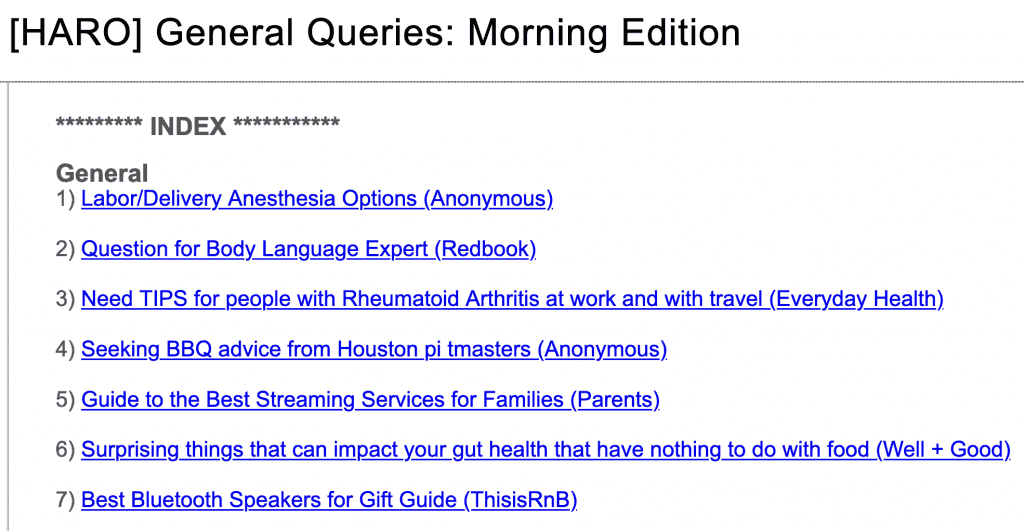
You can then reply to the requests that are relevant to you in the hope that the journalist will like your pitch and include it in their article.
Why should you use HARO?
HARO is ideal for bloggers who want to build backlinks without sending hundreds of annoying outreach emails.
Instead of cold emailing hundreds of blogs to try to convince them that linking to you will make their life better, you offer genuinely helpful advice journalists asked you to provide.
And since HARO is widely used, there are queries for all kinds of business owners. You will find the right pitch opportunity whether you are an expert at the top of your game or a new blogger.
Now you may wonder, does HARO work? I have tried dozens of link building strategies, yet nobody links to me. Do you have some kind of proof?
Yes, I do. Here are just a few of the links I have earned with HARO.

These are mostly links from SEO blogs since I mostly reply to requests regarding SEO and blogging but I have also earned backlinks from Business Insider and other publications.
But you can also use HARO to build backlinks if you are a food blogger, personal finance blogger or any kind of blogger.
For example, food blogger Anna Rider from Garlic Delight started using HARO a while ago and has already earned backlinks from websites like NBC News, Forbes and The Kitchn.
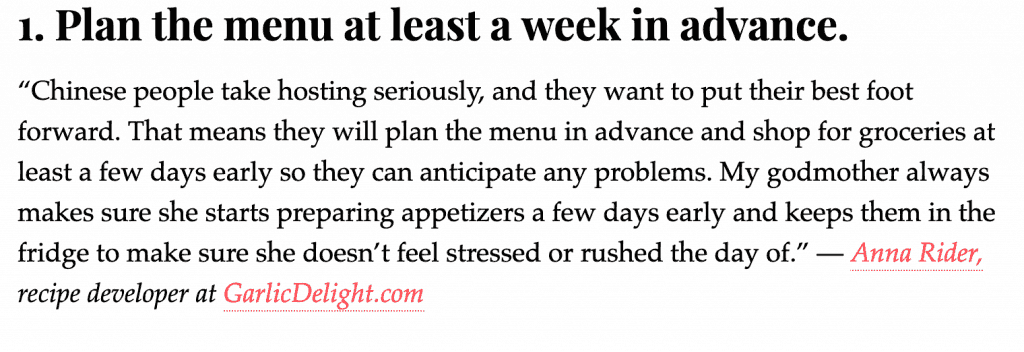

How to choose which pitches to reply to?
Feel like giving HARO a try?
Excellent choice!
The first step is to sign up as a source and tell HARO which categories you are interested in.
You can choose to receive an email from the Master HARO category meaning you will receive all queries that are posted on that day. Or you can choose individual categories.
Starting with the Master HARO category is a great idea because there may be queries you could reply to in categories you didn’t consider. But I only recommend doing it for a few days so you don’t get overwhelmed by the amount of queries you receive. After a few days, I recommend unsubscribing from Master HARO and subscribing to individual categories instead.
Once you receive an email from HARO, it’s time to choose the queries you want to reply to.
Besides the overwhelming number of queries, you will quickly notice that some journalists mention that they want to talk to experts.
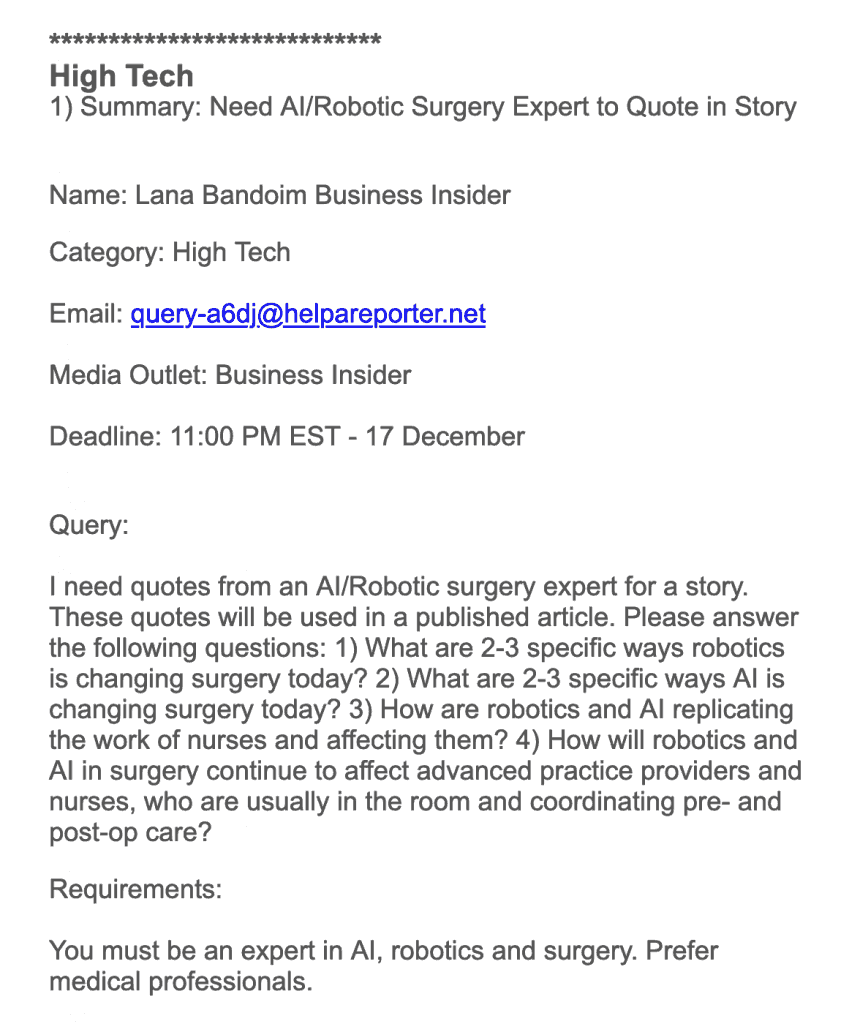
While others have less specific requirements.
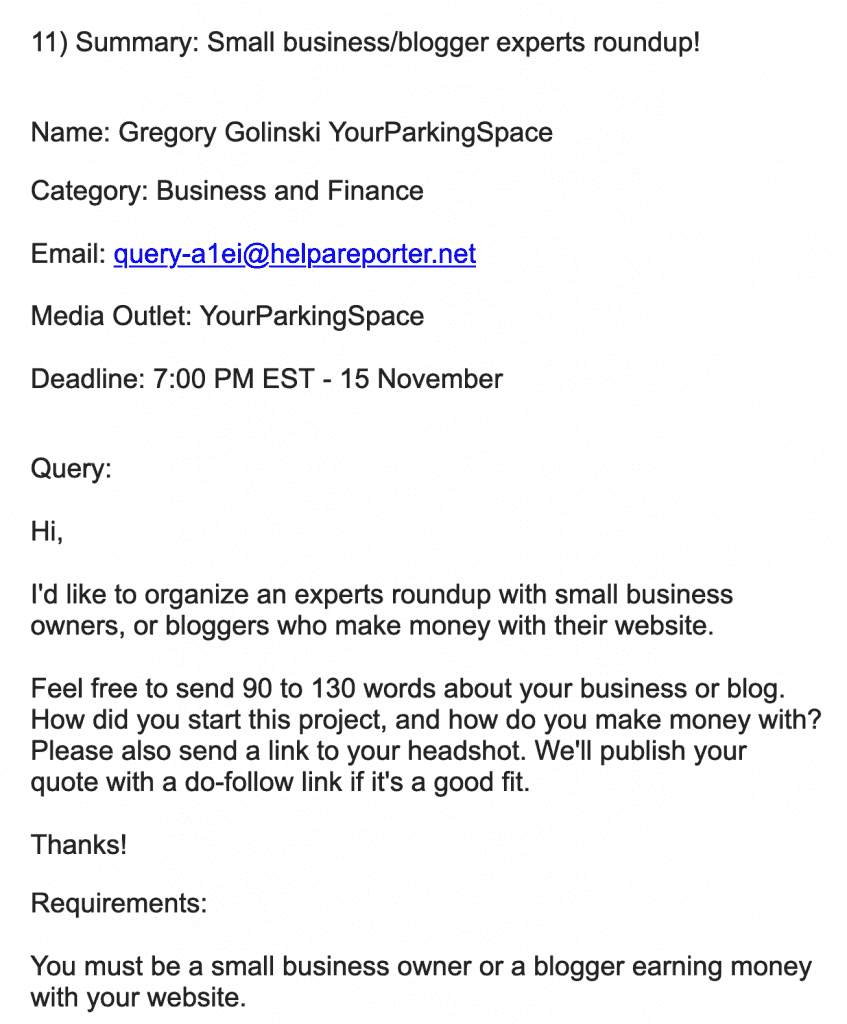
You don’t need to be a professional at the top of your field to succeed with HARO, you simply need to know more about the topic than most of the publication’s readers.
I got featured in several respected SEO blogs despite being relatively unknown in the world of SEO and Anna from Garlic Delight got featured in NBC News even though she is relatively unknown in the world of food blogging.
This doesn’t mean you should reply to all HARO requests though. Journalists receive hundreds of replies and it’s essential to stand out and offer something valuable.
Here are a few questions to ask yourself before answering a query:
- Do I have something interesting to share on the topic?
- Do I fit the requirements the journalist mentions?
- Do I feel excited about answering this query? Is what I’m about to share helpful?
- Is this query related to my niche?
- If it’s not related to my niche, would a backlink on the website still benefit me?
- Would I be happy to display the website’s logo on my “featured on” page?
- Do I still have time before the deadline set by the journalist?
If you can say yes to all these questions, you found the perfect query.
I generally reply to all queries I feel qualified to reply to even if they are not in my niche because earning a backlink from a reputable website can’t hurt.
I also reply to lesser-known publications because it’s important to have a diverse backlink profile and I don’t want to end up only having backlinks from top publications.
However, you may feel overwhelmed and need to prioritize. In this case, I recommend focusing on websites in your niche or on well-known publications you would like to be associated with.
Because here is the thing, HARO is not only about building backlinks, it’s also about building your reputation as a blogger. And a mention in the New York Times could give you a lot of credibility even if the article is not related to your niche.
Providing helpful answers to HARO queries could even help you make valuable connections. This is what happened to Amit Raj, Founder of The Links Guy, when a journalist he pitched ended up setting a call between his client and one of Mark Cuban’s business partners
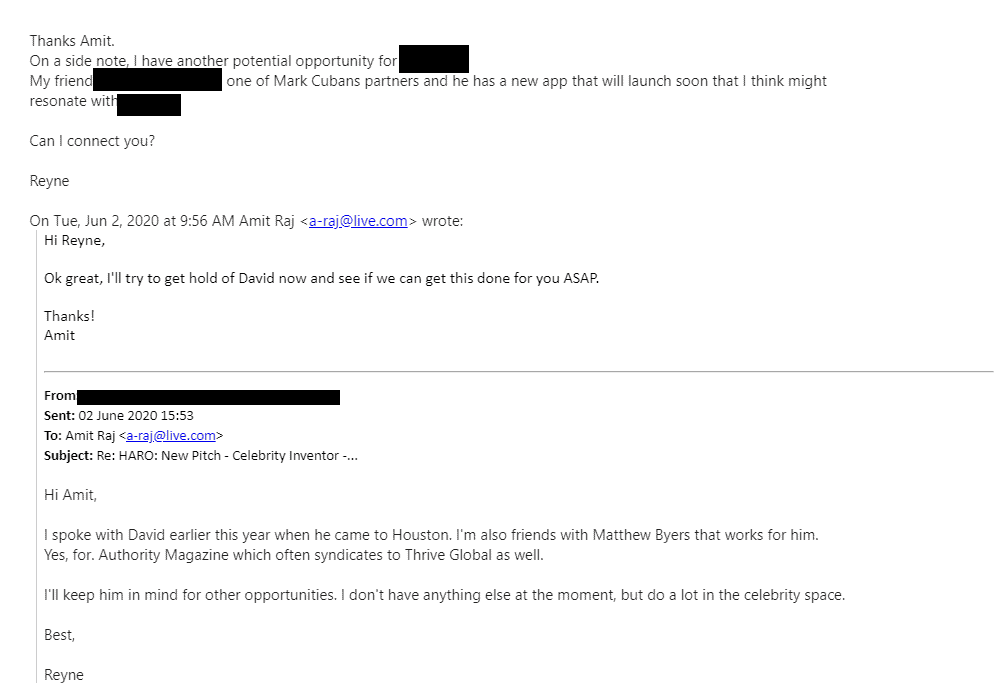
Pro tip: You know how “I work for the government” said by someone who works in Washington DC often means “I work for the CIA”?
Well, with HARO, “anonymous” written as the name of the publication often means “I work for a big publication whose name I don’t want to disclose because it would attract hundreds of low-quality pitches from people desperate to get a backlink.” In other words, it’s often worth it to reply to anonymous publications because they tend to be from respected publications.
On the other hand, it frequently happens that pitches that are supposed to be for a big publication end up being for a little-known website.
How to write your HARO pitch
Once you have identified good queries, it’s time to write your HARO pitch.
Before you do so, it’s important to:
- Check the publication’s content to see what they expect.
- Look at how they quote people. Some publications only include very short quotes while others prefer more in-depth replies.
- Pay attention to their writing style and tone so you can match it in your reply.
You can then write your pitch. When doing so, makes sure that you:
- Write the journalist’s name correctly.
- Include everything the journalist requires.
- Mention why you are qualified to reply.
- Offer a surprising/unusual point of view or a controversial opinion.
- Only add relevant details. Most journalists won’t spend more than a few seconds deciding whether to move on or not.
- Use bullet points so journalists can scan your pitch and see if it’s what they are looking for.
- Include tidbits the journalist can copy-paste into the article (something they often do).
- Make sure there are no typos or errors. Journalists don’t want to waste time editing what you write and will move on if using your pitch is too much work.
I’m not providing you with a HARO pitch template because every pitch is unique and following a template will not help you stand out in a sea of a pitches.
Instead, let me show you a few successful pitches to give you an idea of what works.
5 examples of successful HARO pitches (and why they work)
#1 HARO pitch for Thanksgiving food prep advice in NBCNews
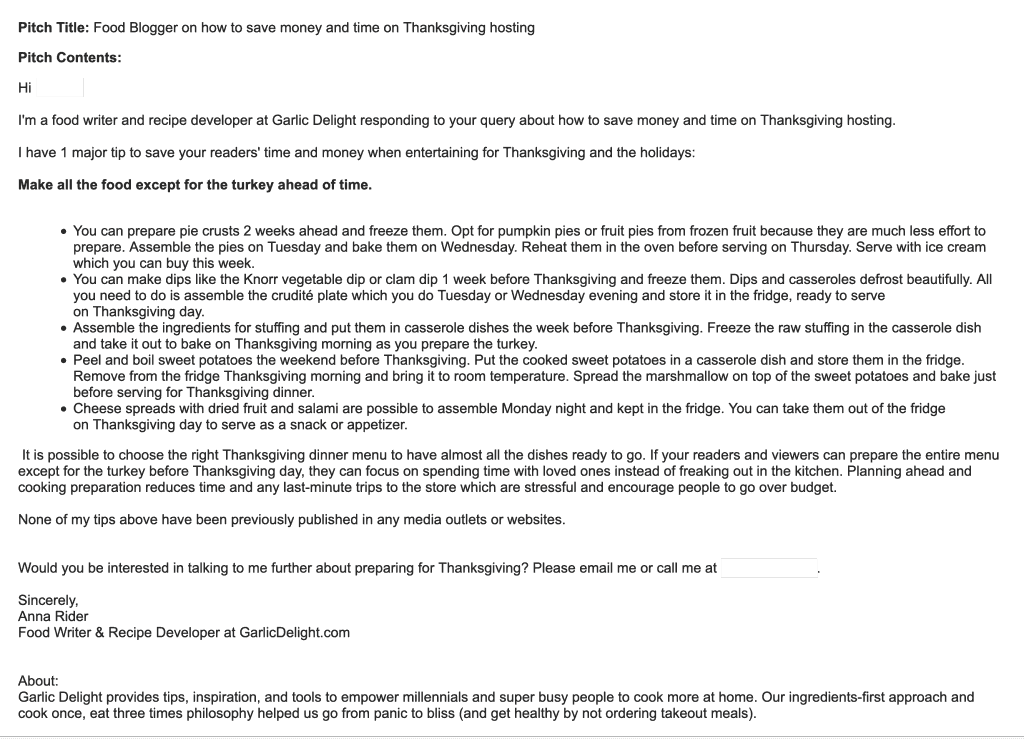
This pitch resulted in a nice NBC News backlink.
Anna first introduces herself and explains why she is qualified to answer but then quickly explains that she has “1 major tip” to offer. This makes the pitch quick to read and immediately shows the value. She then explains how to use her tip with clear bullet points. She also addresses a worry the journalist mentioned in the query (the pitch has to be unique and not published anywhere.)
#2 HARO pitch for a SEO blog
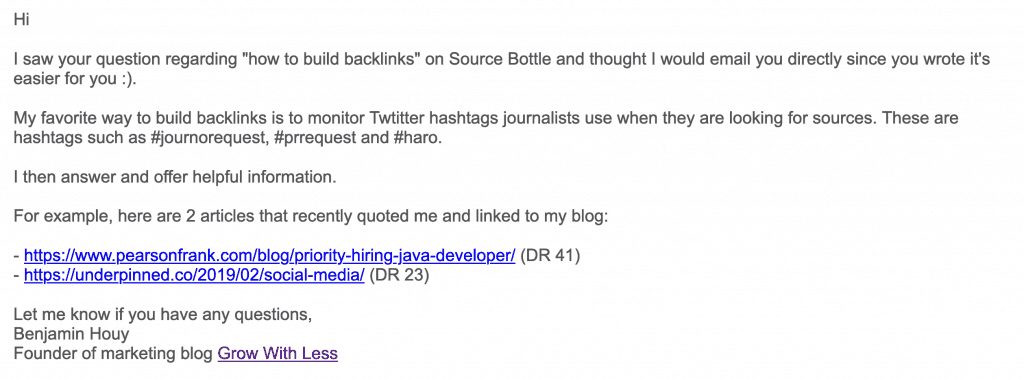
This pitch helped me earn a backlink on the Monitor Backlinks blog. It wasn’t actually on HARO but on Source Bottle, an HARO alternative. The pitch is short and to the point. It offers a clear answer to the question (what’s the best way to earn backlinks?) and shares a link building strategy few people talk about. I also included a few examples of backlinks I built with said technique to show I had success with it.
#3 HARO pitch for a travel article on the Washington Post

This pitch by Sofie Couwenbergh resulted in a backlink and mention in The Washington Post.
It starts with a demonstration of expertise (“I travel about 20 times a year”) followed by a list of actionable tips. This a great pitch because the value is obvious and adding Sofie’s tips to an article requires little effort for the journalist.
#4 HARO pitch for a Business Insider article about freelancing
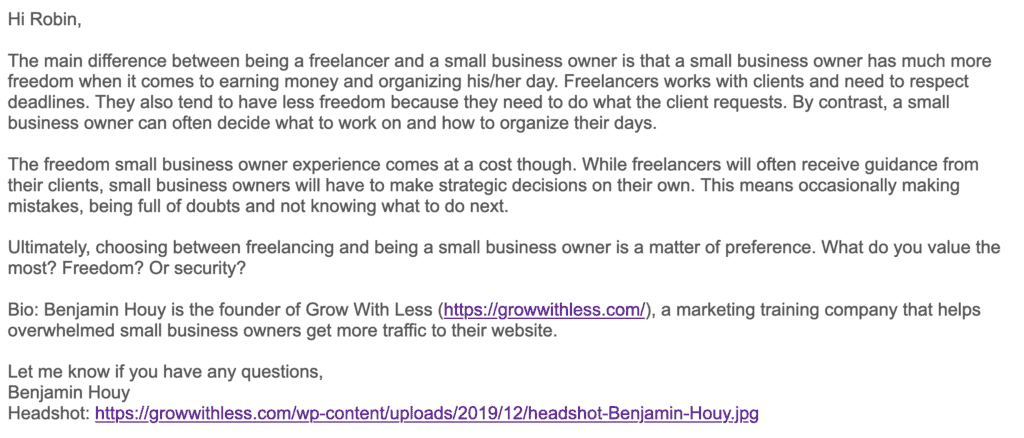
This pitch was in reply to a query about the pros and cons of being a freelancer compared to being a business owner. I started the pitch directly by answering the question and kept it short and to the point. I also focused on a common theme (freedom vs security) so the journalist can easily quote me without making too many changes.
Despite the embarrassing typo, this pitch resulted in a nice Business Insider mention and backlink for Grow With Less.
As you can see, these pitches vary in length and content. That’s because there is no perfect HARO pitch length or format. Like with blog posts, it’s about value, not length.
A successful HARO pitch should:
- Be relevant.
- Be valuable.
- Makes the journalist’s life easier.
Getting the right pitch format can take a while so I recommend trying different approaches and seeing what journalists respond to. You may also want to keep track of all the pitches you send so you can analyze which worked and which didn’t later on.
How to make sure journalists read your HARO pitch
Your subject line is the most important aspect of your HARO pitch because a bad subject line means nobody will ever read the pitch you wrote.
Coming up with a great subject line may seem overwhelming but it doesn’t have to be complicated.
To get started, ask yourself the following questions:
- What’s the key takeaway from my pitch?
- Is there anything particularly intriguing or surprising in the pitch?
And write something intriguing but clear.
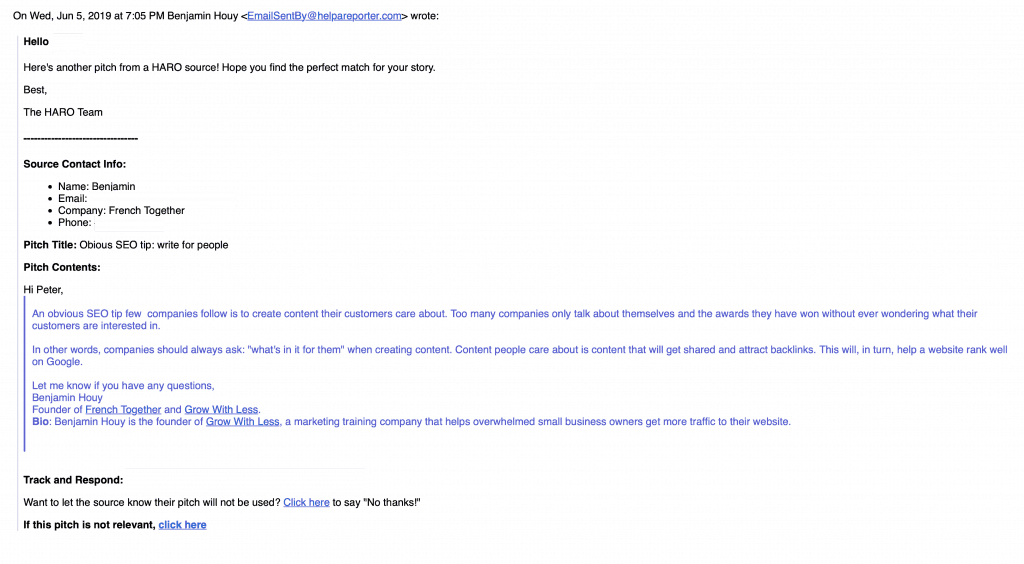
Just make sure your subject line stays short. HARO adds “HARO: New Pitch -” before your subject line when sending your pitch to journalists so you don’t have a lot of space left.
Just like with pitches themselves, I recommend trying different types of subject lines to see what works best for the publications you are pitching.
The key ingredients your HARO pitch must contain
I already said it and I will say it again because understanding this is the key to succeeding with HARO: journalists have a lot on their plate.
They don’t want to go back and forth to get more info so make sure you always include the following alongside your pitch:
- A bio that’s relevant to the pitch and shows you are qualified to answer.
- A link to a headshot (better than an email attachment because some journalists complain that attachments don’t show up in HARO.)
- A link to your blog or a relevant article you wrote.
- A phone number (I don’t like talking on the phone so I don’t do it but it could help)
- Anything else the journalist mentions in the query
You may not need all these things but including them means the journalist can use your pitch right away and doesn’t need to contact you to request a missing headshot or link (something they may not do if they are in a hurry).
Why you shouldn’t folow up
You may be tempted to follow-up after sending a pitch but I strongly recommend against it.
Journalists are busy (did I say that enough?) and will ignore your message at best, complain and get you banned from HARO at worst.
You should, however, make sure you don’t miss any questions the journalists may ask if they choose to include your pitch.

If you get a message saying your pitch was included. Thank the journalist and share the content if it’s relevant to your audience.
You could also let them know you are available if they have other questions on the topic. This can work well if the journalist loved your pitch and could lead to a long term collaboration.
For example, SEO blog Databox invited me to contribute to other articles after I replied to one of their requests.
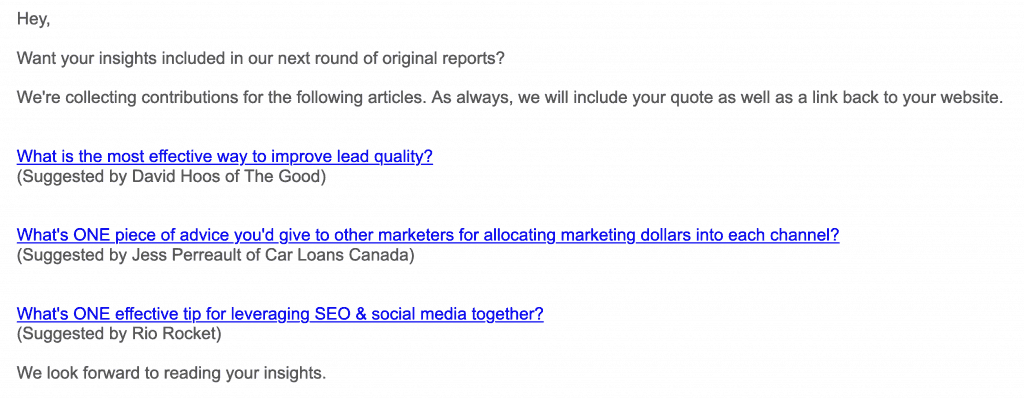
This has resulted in Grow With Less being mentioned in several Databox articles.

Don’t let your HARO mentions go to waste
Getting backlinks from HARO is amazing but HARO isn’t just about getting backlinks and it would be a shame to stop there.
It’s a good idea to display the logos of the well-known publications you were featured in on your home page or on your “as featured in”/press page.
This will give you instant credibility and help you earn more backlinks naturally because other website owners will take you more seriously.
Just make sure you are legally allowed to display the publication’s logo.Some newspapers such as USA Today explicitly mention that you need to ask for permission before doing so.
What to expect (and not to expect) from HARO
Lots of bloggers use HARO for a day or 2, get no replies and decide to add it to their list of useless link building strategies.
That’s a huge mistake because it takes a while to get used to HARO and find out what journalists respond to.
From my experience, roughly 20% of pitches will get a reply and 10% will be used but this could vary depending on your niche so don’t be discouraged if you don’t see results at first.
The success you have will also depend on the time of the year. Anna from Garlic Delight found that she got way more positive replies just before Thanksgiving when journalists were anxious to find Thanksgiving content ideas.
It’s also important to note that journalists won’t always tell you they plan to use your pitch and that it can take months before your pitch appears in an article. My Business Insider pitch was published 4 months after I sent it.
You also need to accept that you won’t always get a backlink. Some publications rarely include backlinks while others use nofollow backlinks (meaning it won’t benefit you SEO-wise). That’s part of the game and expecting to always get a dofollow backlink will only lead to disappointment.
Finally, and I wish I didn’t have to mention this but some publications (often lesser-known ones) will try to blackmail you into giving them a backlink by saying they will only link to you if you link to their article first or pay them.

A content writer from a well-known tech publication asking me to pay for a backlink.
If this happens, I recommend deleting their email and making a mental note never to work with the publication again.
It’s time to write your pitch
Voilà, you now know everything you need to start building backlinks with Help A Reporter Out (HARO).
I recommend signing up now if you haven’t already done it and trying to reply every day for at least a month.
Doing it for at least a month is essential because there are days when you will feel that you are wasting your time followed by weeks when you will suddenly get lots of positive replies.
If you don’t stay the course, you will not know whether HARO wasn’t for you or whether you gave up too quickly.
So write in your todo list that you will use HARO every day for a month and give it a try. You have nothing to lose and a lot of traffic and backlinks to gain.
Featured image credit: Sarah Boudreau - Unsplash